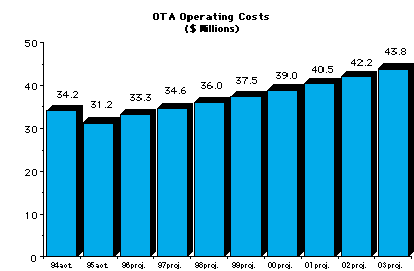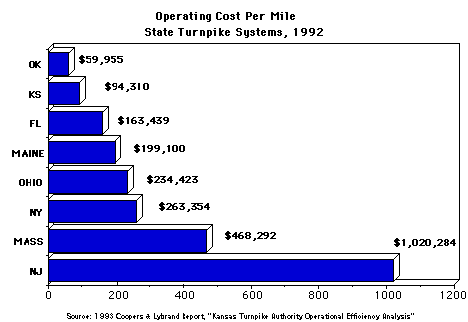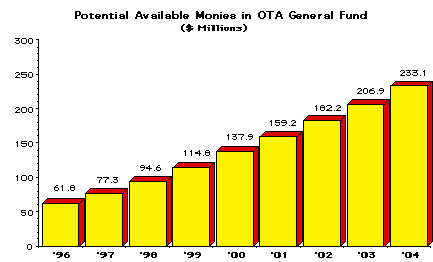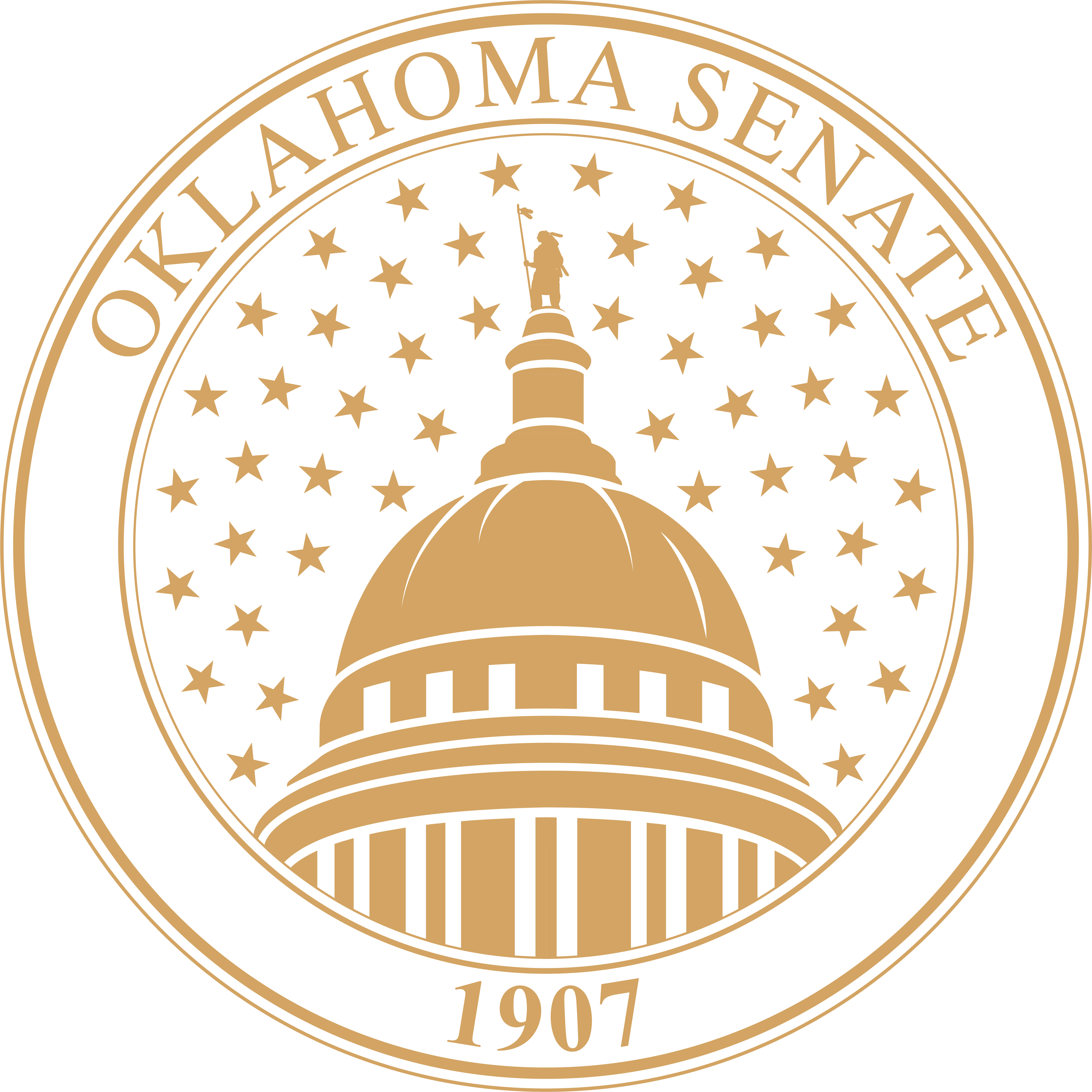PERSPECTIVES ON THE OKLAHOMA TURNPIKE AUTHORITY
Revenues
The Oklahoma Turnpike Authority (OTA) in 1995 derived 98.8% of its $106 million in operating revenues from tolls. The balance of its operating revenues comes from concession contracts with businesses along turnpikes. Another source of income, called non-operating revenue, was $11.7 million interest earnings on $145.4 million in cash that is invested in a variety of instruments.
Toll revenue is impacted by two factors: toll rates and traffic.
Traffic growth is affected by normal growth patterns such as population increases, and by new turnpikes added to the system. Traffic over the past decade has increased between 3% and 23% a year. New turnpikes -- Cherokee and Kilpatrick opened in 1991, Creek in 1992, Chickasaw in 1993 -- created double-digit traffic-growth percentages. Absent new roads, turnpike system traffic has grown an average of 6% a year since 1994. In the 1996 OTA turnpike expansion proposal, traffic is projected to increase an average of 4% a year through 2002 on existing turnpikes.
Rates of tolls are increased by vote of the Authority. Rates were last increased by about 4% in February 1995. Previous toll increases were enacted in 1993, 1991 and 1979. In 1993, the Authority adopted a plan to increase tolls biennially at rates tied to the Consumer Price Index. After the 1995 toll increase, however, the Authority repealed the biennial adjustment plan.
OTA assumes no inflationary toll increases will be necessary, according to its 30-year budget models. The 1996 turnpike expansion plan's 10% rate increase would generate sufficient funds to pay debt service on the new turnpikes and projected inflationary budget pressures that in the past have caused OTA to order toll increases.

Revenue Projections
OTA has had mixed results in projecting toll revenue.
Projections for revenues on the existing turnpike system have been close to actual revenues. The agency contracts with Wilbur Smith Associates periodically for 10-year traffic projections. Traffic projections are combined with rates to estimate toll revenues. Over the past three years, OTA's actual collections have turned out to be between 3% above and 0.5% below projections, with an average error rate of 1.8%.
On proposed turnpike expansions, revenue projections have been much less reliable. This can be illustrated by comparing the last revenue estimates for proposed turnpikes (traffic and feasibility studies by Wilbur Smith Associates dated March 3, 1988) with actual data on the same turnpikes.
Before the Kilpatrick Turnpike was built, OTA projected 1996 revenue of $10.3 million and a traffic count of 29,259 vehicles at the busiest segment. Actual revenues will be about $3.6 million on 20,000 vehicles, based on annualization of year-to-date data. Thus, actual revenue will be $6.7 million or 65% below estimates.
Before the Creek Turnpike was built, OTA projected 1996 revenue of $6.5 million and a traffic count of 32,209 vehicles at the busiest segment. Actual revenues will be about $3.9 million on 25,000 vehicles, based on annualization of year-to-date data Thus, actual revenue will be $2.6 million or 40% below estimates.

Operating Expenses
In 1996, OTA is budgeted to spend $33.3 million running and maintaining the state turnpike system, employing about 490 FTE. It also will spend $51.7 million in payments to bondholders. It will spend $14.6 million on major maintenance projects required by trust agreements (see Reserve Maintenance Fund, p. 8). Excess monies of $20.6 million will be deposited into the OTA General Fund.
Cash flow budgeted for 1996 is illustrated as follows:
Income
Amount
+ Tolls and concession contracts
$112,565,000
+ Interest earnings on fund balances
7,553,000
Expenses
- Agency Operations and Maintenance Costs
33,300,000
- Payments to Bondholders
51,653,000
- Maintenance Reserve Fund
14,570,000
Profit/(Loss)
= Deposit to General Fund
20,595,000
Operating costs have been reduced in recent years under an austerity plan invoked by Director Neal McCaleb. OTA plans anticipate 4% growth in operating costs.

A Coopers & Lybrand study of various state turnpike systems found that, in 1992, Oklahoma's system was one of the nation's most efficient. The study, which included only states whose turnpike systems were similar in function and rural/urban mix, found OTA's per-mile operating costs were 74% below average and 36% below Kansas, the next lowest state.

Debt service is the authority's largest expense item at about $51.7 annually. These costs would increase by $38.1 million or 74% under the 1996 turnpike expansion proposal.

Extraordinary Capital Projects
Trust indentures require OTA to commit certain amounts annually to a Reserve Maintenance Fund ($15 million in 1996). That stipulation is designed to give bondholders assurance that the system's revenue-generating capability will be maintained. In determining the Reserve Maintenance set-aside, consulting engineers surveyed the system and predicted the cost of all capital improvements necessary through the year 2022. Thus the Reserve Maintenance Fund could by itself provide funds necessary for essential capital improvements to the 10 turnpikes.
In 1995, OTA began an extraordinary capital improvement plan, the OTA Five-Year Capital Plan. The plan makes investments well beyond those required by legal obligations. To finance the $197 million plan, OTA plans to use discretionary general funds of $120.7 million added to $76.8 million set aside in the Reserve Maintenance Fund.
The 1994 Walters turnpike expansion proposal included about $119 million in major maintenance projects that would have been financed with revenue bonds. These projects included repaving and installing median barriers along the Turner and Will Rogers turnpikes. Those same projects are now being financed with General Fund cash as part of the OTA extraordinary capital plan.
Cash Balances
OTA accumulates its "profits" -- earnings above obligations -- in the Oklahoma Turnpike System General Fund. The Authority may use General Funds for any lawful purpose of the Authority. The balance in the General Fund is a gauge of the agency's fiscal health.
The fund's year-ending balances averaged $11.4 million between 1985 and 1989. From 1990-95, the year-ending balance averaged $68.4 million -- a 500% increase. Earnings from four new turnpikes opened in 1991-92 and toll hikes enacted in 1991 and 1993 caused OTA income to increase faster than expenses, resulting in increased balances.
No balance is required to be kept in the General Fund; money is deposited to the fund only after all legal obligations to bondholders and all operating costs are met. General Fund reserves are invested in a variety of instruments and earn interest. Typically the funds have been used to finance feasibility studies on future turnpikes, to develop the PIKEPASS system, to provide cash flow to other funds, and to make emergency road and bridge repairs.
In 1995, OTA began using General Funds for a new purpose. It adopted a 5-year plan to make extraordinary capital improvements to the turnpike system (see Extraordinary Capital Projects, p. 8). The plan reduced the General Fund balance by $43.4 million in 1995 and will encumber another $23.7 million in 1996.
Assuming extraordinary capital expenditures do not continue, the General Fund balance will grow steadily, reaching $233.1 million in 2004.

- 1996 figure based on OTA 1996 budget
- 1997-2004 figures based on the following assumptions:
1. Excludes 5-Year Capital Plan Expenditures
2. Routine capital expenditures will begin at 1991-96 average, indexed 4% annually for inflation
3. Revenues according to OTA projections
4. Beginning balance is invested and earns 6% interest annually
 Oklahoma Senate
Oklahoma Senate

